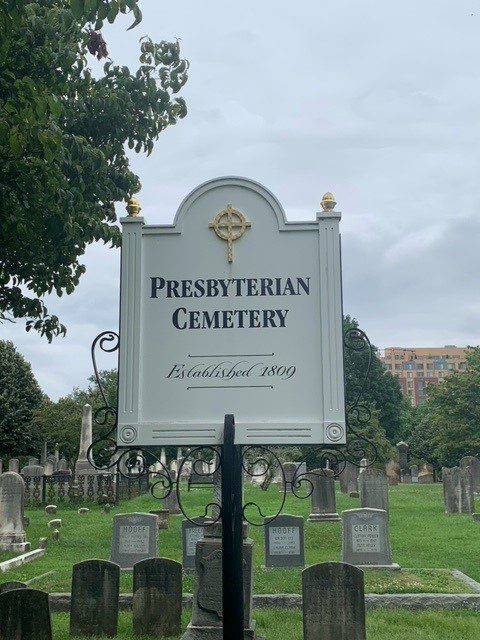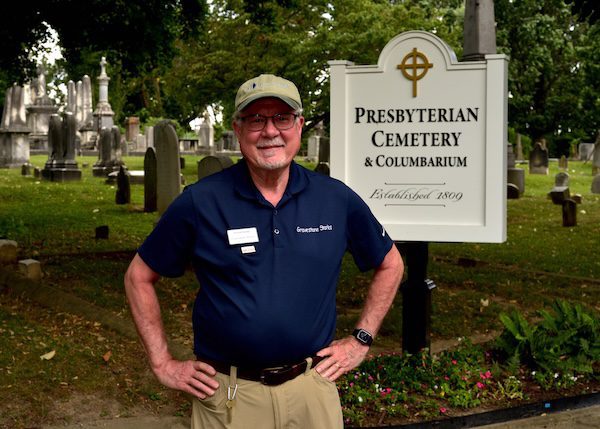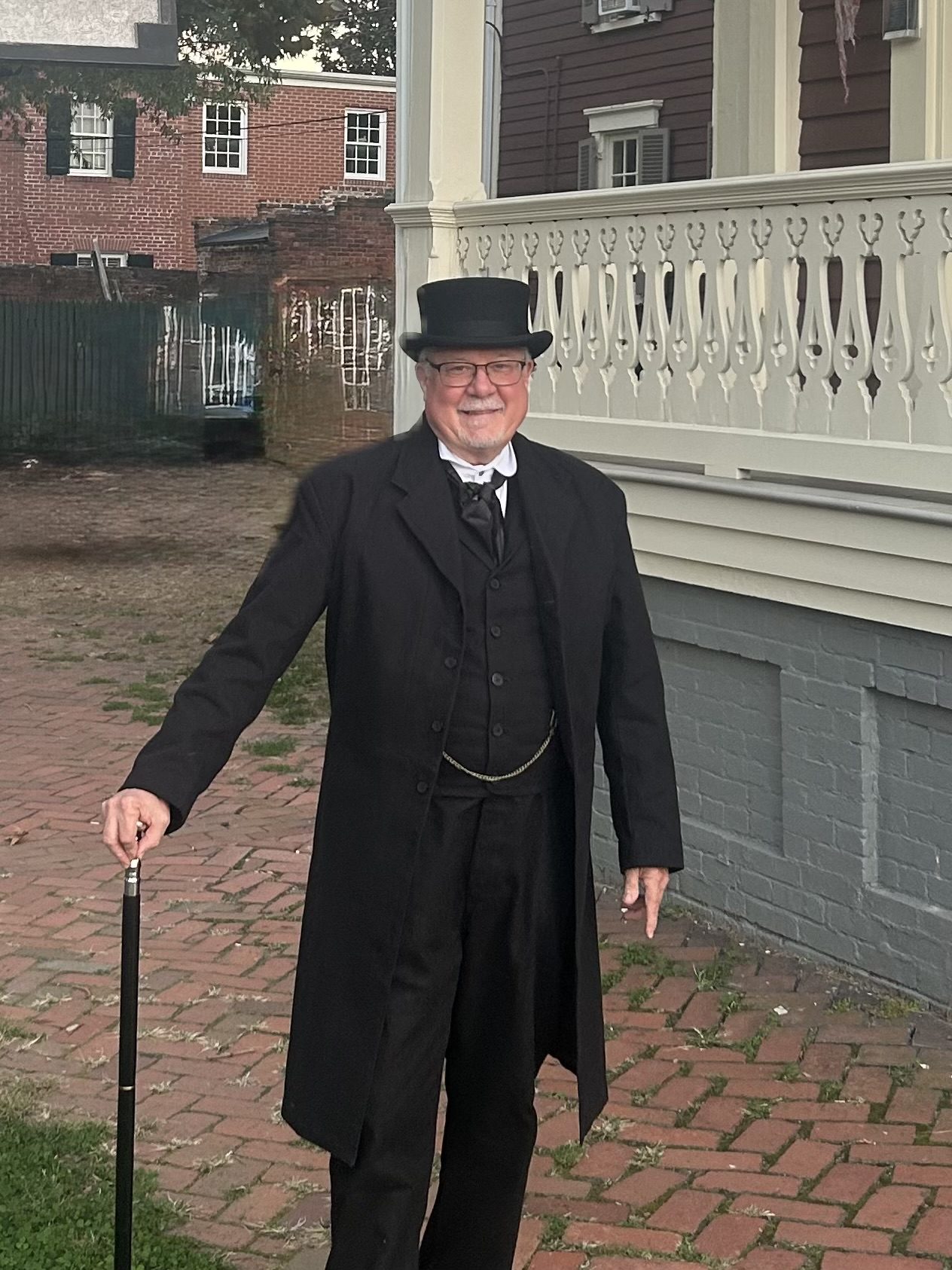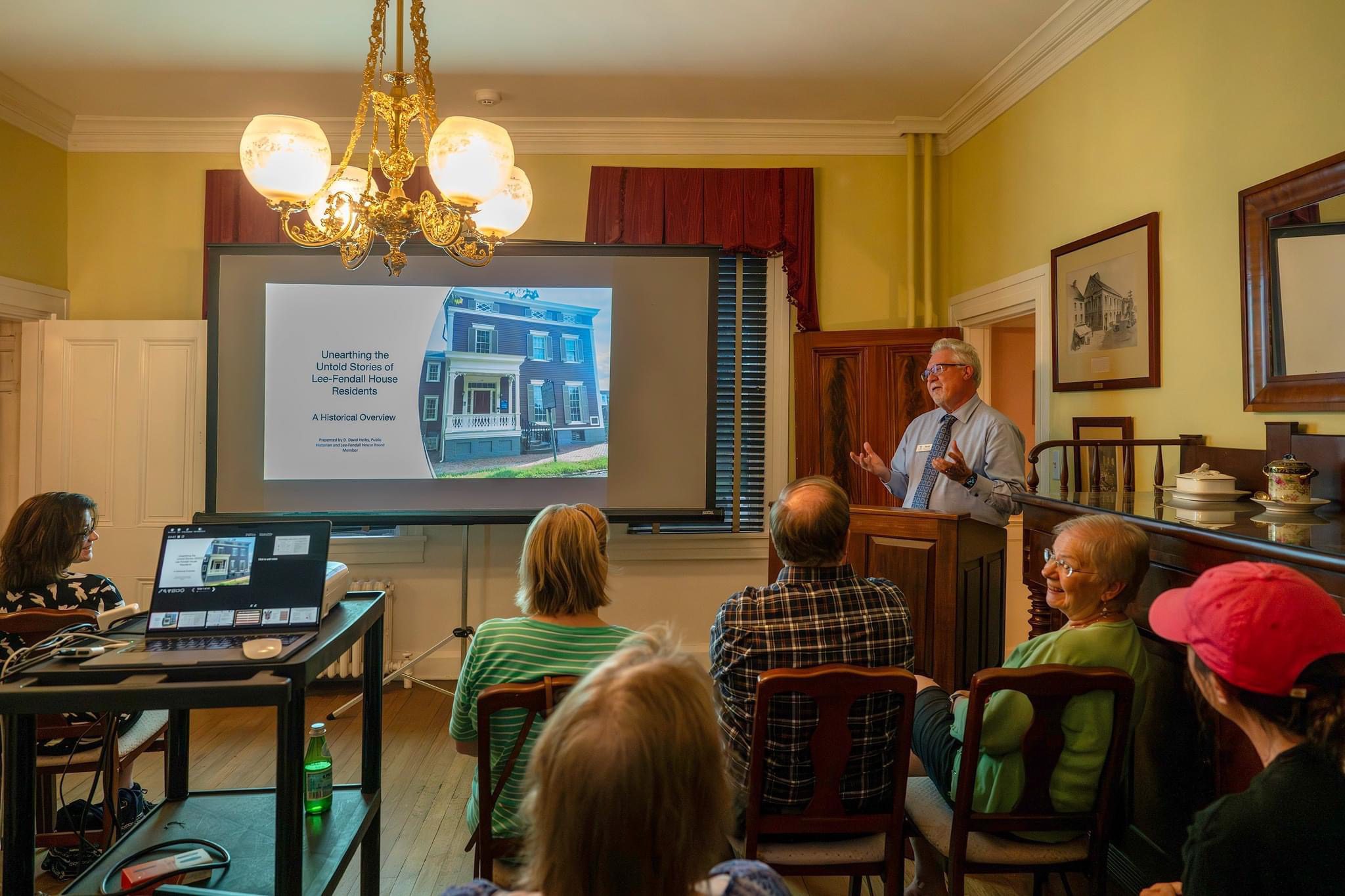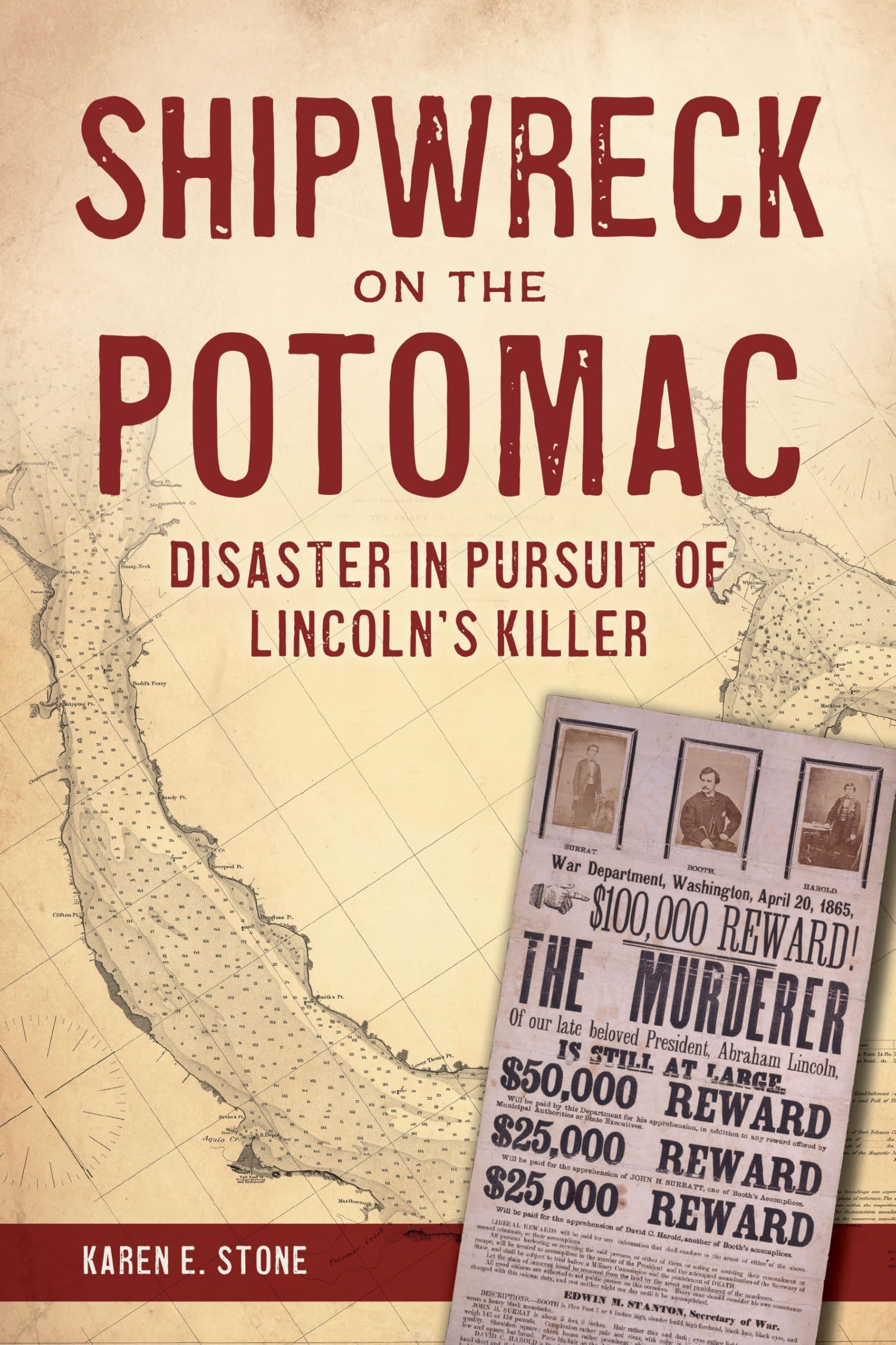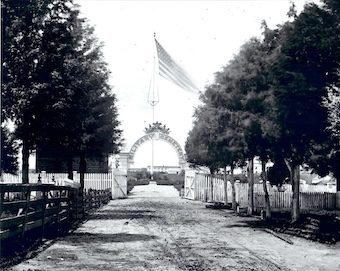Welcome to Part 2 of the Presbyterian Cemetery Distinguished Stories Collection, highlighting individuals with surnames beginning H through N. These stories continue our exploration of Alexandria’s civic, cultural, and military past—from influential families and church leaders to educators, business owners, and soldiers whose lives shaped the fabric of this historic city.
Each profile offers a deeper understanding of the people interred in one of Alexandria’s most important cemeteries, where memory and legacy endure in stone.
Explore other sections in this series:
- Part 1: Surnames A–G
- Part 2: Surnames H–N (you are here)
- Part 3: Surnames O–Z
This H-N section begins with surnames starting with H:
H
Captain William Harper (April 14, 1761 – April 18, 1829), Multifaceted Patriot: Revolutionary War Veteran, Rope Maker, City Council Member, and Commander of Artillery at Washington’s Funeral
Hailing from Philadelphia, he tied the knot with Mary Scull Harper (1763 – 1842) on June 14, 1781. Their union bore fruit in the form of a son named Dr. William Harper (as mentioned in the details below).
A participant in the Battle of Trenton and a winter survivor of Valley Forge, Captain Harper marched alongside Washington, braving the icy Delaware River during the New Jersey campaigns of December 1776 and January 1777.
His enterprise specialized in crafting ropes, likely situated at Jones Point. In 1810, Alexandria hosted three establishments dedicated to rope production, churning over 400 tons of this essential commodity.

Harper’s affiliations extended to the Masonic Lodge, where he held membership, and he stood as a prominent member of the Relief Fire Co. Notably, he commanded the Alexandria Artillery during the commemoration of Washington’s Birthday in 1799, as well as during the somber procession for Washington’s funeral at Mount Vernon on December 18, 1799.
Furthermore, he assumed the lead of the Artillery Company, orchestrating their role in the reception of President Thomas Jefferson upon his visit to Alexandria in 1801. The rendezvous occurred at Gadsby’s Tavern on Saturday, March 14, 1801, and witnessed the presence of President Jefferson, the Vice President, the Secretary of War, the Attorney General, and Major General Wilkinson. (Source: Michael Miller, Pen Portraits Alexandria, Virginia, 1739-1900, Pg. 49.)
Harper’s inclusion as one of President John Adams’ selections for the Justice of the Peace role, known as the “midnight appointments,” drew contention. This appointment was pivotal in the Marbury v. Madison case in the U.S. Supreme Court. Intriguingly, Harper, despite his nomination, never actually assumed the position. Chief Justice John Marshall’s ruling on the case cemented the doctrine of judicial review. This doctrine, an integral component of the “checks and balances” system, prevents any branch of the Federal Government from amassing unchecked power.
Buried in Section 42, Row 43, Plot 8.
Dr. William Harper (April 23, 1787- October 7, 1852) Defender in War and Faith: War of 1812 Veteran and Ruling Elder of the Second Presbyterian Church
The son of Captain William Harper (April 14, 1761 – April 18, 1829) and Mary Scull Harper (1763 – 1842) was laid to rest in location 42:43. Captain Harper actively participated in the Second Presbyterian Church of Alexandria, which is not present anymore.
William Harper was ordained and installed as a Ruling Elder of the Second Presbyterian Church on June 26, 1842.
Harper and Mary Thomas Newton married on October 17, 1810, near Leesburg, Virginia. They had ten children, including Wells Andrew Harper, who was born on September 2, 1818, and passed away on December 7, 1876. Wells served as a member of the city council from 1860 to 1861. Another son, John Newton Harper, was born on March 25, 1823, and died on August 3, 1907. He fought for the Confederacy as a Company G, 23rd Virginia member.
During the War of 1812, Harper served as a soldier in the Sixtieth Regiment of the Virginia Militia. He fought in the Battle of the White House.
Dr. Harper died on October 7, 1852, and is buried in section 43:111. A large obelisk with a shroud on top marks his grave, along with his wife and several of their children.
The Reverend Elias Harrison (January 22, 1790 – February 13, 1863) – Dedicated Meeting House Pastor: Succumbed to a Broken Heart after Years of Service

Served as the Associate Pastor of the Meeting House from March 17, 1818, and then Pastor from 1820 until 1863. During his time, the first Meeting House burned down on July 26, 1835. After rebuilding it in 1837, he continued serving until his death on February 13, 1863. He died of extreme sadness. He couldn’t perform weddings or funerals when the Federal Government occupied Alexandria during the Civil War because he didn’t want to promise loyalty to the United States. Most Meeting House members who died during the war were buried in Ivy Hill Cemetery on King Street. There is a memorial dedicated to Reverend Harrison on the south wall of the Meeting House.
| ELIAS HARRISON, D.D. born in Orange Co., New York and for 41 years Pastor of the First Presbyterian Church, Alexandria departed this life Feb. 13th, 1863, aged 73 years. He was a good man and full of the Holy Ghost and of faith; and much people was added unto the Lord. Acts 11th Chap. 24th Ver. |
| Sacred to the memory of ELIZABETH the beloved wife of the Revd. ELIAS HARRISON who departed __ this life __ __, of a good hope through ___. May the 6th A.D. 1824, in the 26th year of her age. Perfect she was not, else she had not been mortal yet what she was and whence she would hardly be disposed to memory. A winning openness of manner a sincerity without smile a disposition amiable and affectionate a piety modest and ___ her a grateful measurable and th___ the ___ sweet. The heart of her husband could solely trust in her for looking well in the way of her household and has long… ___ ___ the days of her life. ___ |
Alva Lee Harvey (May 22, 1900 – December 1, 1992) – Trailblazing Aviator: Honored with the Distinguished Service Medal
Harvey, a person from Texas, is famous for his actions as a U.S. Army Air Service member during the 1924 First Flight Around the World. He was awarded the Distinguished Service Medal for his participation. He led groups of bombers in the Pacific region in World War II.
Read the blog The First Around-the-World Air Flight for the rest of the story.
He was buried in Section 3, plot 21, with his wife, Lillian.

The Henderson Children – A Tale of Loss in Early Alexandria
In Section 43:104 lie two young children of Colonel Archibald Henderson and Anne Marie Cazenove Henderson, their small graves telling a poignant story of 19th-century family life, loss, and the personal sacrifices of a notable military family.
Paulina Cazenove Henderson, who passed away on July 29, 1833, in her fourth year, and Archibald Murray Henderson, an infant son born July 1, 1845, who died August 29, 1846, rest here among their maternal relatives. Their father, Colonel Archibald Henderson (1783-1859), would become known as the “Grand old man of the Marine Corps,” serving as its Commandant for an unprecedented 38 years from 1820 to 1859.

Colonel Henderson’s illustrious career included heroic service aboard the USS Constitution during the War of 1812 and successful efforts to maintain the Marine Corps’ independence. He led Marines through the Mexican-American War, a campaign that would inspire the Marine Corps hymn. Notably, the sword presented to Henderson after this conflict bore the inscription, “From the Halls of Montezuma, to the Shores of Tripoli,” which became the opening words of The Marines’ Hymn.
While shaping Marine Corps history, the Hendersons also faced personal tragedy. Their children’s resting place here, separate from their parents in Congressional Cemetery, speaks to the family’s deep ties to Alexandria and the complex tapestry of early American life.
The children’s parents, Archibald and Anne Marie, were married on October 15 or 16, 1823, in the Presbyterian Meeting House by the Rev. Harrison. The presence of these children here, while their parents rest in Congressional Cemetery, highlights the strong connections between Alexandria’s families and the city’s rich history.
Visitors to this section can reflect on these young lives cut short, offering a glimpse into the personal side of one of early America’s notable military families. These small graves serve as a poignant reminder that even as Colonel Henderson was shaping the future of the Marine Corps, he and his wife faced the timeless struggles of parenthood and loss.

| PAULINA daughter of ARCHIBALD and ANN M. HENDERSON died 29th July 1833 in her fourth year God took thee in his mercy A lamb, unmastered untried he fought the fight for thee He won the victory And thou art sanctioned |

| In memory of ARCHIBALD MURRAY infant son of Gen. ARCHIBALD and ANNE M. HENDERSON born July 1, 1845 died August 29th, 1846 |
Sherman Curtis Hildreth (November 9, 1917 – February 11, 2012)
Mr. Hildreth was a member of the Cemetery Board of Directors. Buried in 2:2:5.
Continuing through the Alexandria Presbyterian Cemetery H-N records, we find these notable I surnames:
I
James Irwin (1757-1822): A Life of Service and Industry
James Irwin, also known as James Irvin or James Irvine, was a prominent figure in early American history, born in 1757 in Belfast, Northern Ireland. He immigrated to the United States and became deeply involved in civic and religious communities.
Irwin was an elder and active participant in the Presbyterian Church, serving multiple times as a commissioner from the Presbytery of Baltimore to the General Assembly between 1790 and 1822. His commitment to his church was further demonstrated through his involvement in various committees, including the Meeting House Church Committee and the Church Committee responsible for a lottery to fund a bell tower and steeple in 1790.
Aside from his religious endeavors, Irwin was a respected member of the Alexandria, Virginia community. He was a Justice of the Peace in 1796, a member of the City Council, and contributed significantly to the local economy and culture. As a charter member of the Alexandria Library Company in 1794 and a member of the St. Andrew’s Society, he helped foster community and learning.
Irwin’s business acumen was evident in his role as a ropemaker, an important trade in the maritime economy of Alexandria. He was also a commissioner of the Domestic Manufacturing Company, a director of Farmer’s Bank, and involved in other ventures, including the Bank of Alexandria and the Bank of Virginia. His entrepreneurial spirit was further exemplified by establishing a ropewalk on his property, Mount Erin/Mount Airy, a testament to his ingenuity and industry.

His engagement with civic duties did not stop there. He was a member of the Relief Fire Co., and a signer of significant documents such as the deed for Presbyterian Cemetery property and the incorporation papers for the congregation in 1809. He also served as a vestryman and helped establish Bellevue plantation (now the location of Marina Towers, 501 Slater Lane).
His role marked Irwin’s personal life as a family man and a slaveowner, a common practice among his contemporaries. He was a guardian to the orphaned Adam children and diligently managed their affairs.
A notable acknowledgment of Irwin’s service is his inclusion on the cemetery plaque that lists veterans of the Revolutionary War, commemorating his contribution to the nation’s fight for independence.
Sadly, Irwin’s life came to an end on September 5, 1822, after a bout with fever. He was 65 years old. His death was mourned by many, and he was laid to rest in the Presbyterian Cemetery, an area he had helped secure years earlier. His legacy as a community leader, devout church member, and industrious businessman remains significant in early American history.
| JAMES IRWIN of Belfast, Ireland the faithful Guardian of JOHN ADAM died Sept. 5, 1822 |
The Alexandria Presbyterian Cemetery H-N directory includes these distinguished J surnames:
J
Andrew Jamieson (1749 – July 6, 1823) – Internationally Renowned Biscuit Artisan
During the Quasi-War with France, which unfolded between 1798 and 1800, primarily in the Caribbean and off the East Coast of the United States, Jamison, along with other bakers from Alexandria, played a vital role. Together, they supplied more than 40,000 pounds of bread to the United States Navy stationed in Philadelphia and Boston.
The Jamieson Bakery, initially established by Andrew Jamieson in 1785 at Ramsay’s Wharf, later relocated to a three-story brick building in Alexandria by 1836. Alongside his son, Robert Jamieson (April 29, 1796 – April 10, 1862), they founded the renowned Jamieson Steam Bakery at the intersection of Lee and Oronoco Streets in Alexandria. Known for producing high-quality crackers, the bakery gained renown, with Queen Victoria importing their products for the Royal table. By 1850, the bakery boasted twelve employees and a significant capital investment. Despite the addition of steam-driven machinery, the business faced challenges in subsequent years.
During the Civil War, it’s uncertain whether the Union army utilized the bakery. After the war, a fire damaged the building, but it continued operating until 1873 when George R. Hill bought it and resumed cracker production. The bakery was eventually torn down in 1888 to make way for wholesale warehouses. Archaeological excavations revealed the brick footings of the warehouses and the stone foundations of the bakery. The bakery included three rooms, a well, and a cistern, likely used for baking and operating the steam engine (Reber, 2010).
The Jamieson Bakery, initially established by Andrew Jamieson in 1785 at Ramsay’s Wharf, later relocated to a three-story brick building in Alexandria by 1836. Alongside his son, Robert Jamieson (April 29, 1796 – April 10, 1862), they founded the renowned Jamieson Steam Bakery at the intersection of Lee and Oronoco Streets in Alexandria. Known for producing high-quality crackers, the bakery gained renown, with Queen Victoria importing their products for the Royal table. By 1850, the bakery boasted twelve employees and a significant capital investment. Despite the addition of steam-driven machinery, the business faced challenges in subsequent years (Reber, 2010).
Andrew, serving as a trustee of the Meeting House and a signatory on the 1809 deed for the Presbyterian Cemetery, was interred in grave number 41:28. Robert, also buried in the Presbyterian Cemetery, contributed significantly to the family’s legacy. Furthermore, Jamison Avenue, located just north of the Wilkes Street Cemetery Complex, is named after the Jamieson family, underscoring their enduring impact on the area.

| In memory of ANDREW JAMIESON a native of Scotland who departed this life on the 6th July, 1823 in the 74th year of his age Marth the perfect man and behold the upright; for the end of that man is peace Psalm 37 Ch. 37 V. |
Robert B. Jamieson: A Life of Faith, Firefighting, and Flour
A civic-minded entrepreneur and philanthropist, Robert B. Jamieson played a leading role in Alexandria’s industrial, religious, and social development during the first half of the 19th century. The son of Andrew and Mary Jamieson (see above), Robert co-founded the Jamieson Steam Biscuit Bakery at Lee and Oronoco Streets, a prominent business that earned him the listing of “biscuit baker” in the 1860 Census. The family legacy lives on in the name of Jamieson Avenue.
Jamieson served as an elder of Second Presbyterian Church from 1830 and frequently represented the congregation at presbytery meetings. He was active in many reform movements of the era—helping organize the local Temperance Society in 1830, attending the 1837 meeting of the American Colonization Society, and managing the Alexandria Colonization Society. A trustee of multiple charitable institutions, he supported the Female Orphan Asylum and was a founding incorporator of both the Alexandria Widow’s Home and Orphan Asylum for Boys.
His public service and business leadership included roles as:
- Treasurer of Masonic Lodge No. 22
- Commissioner of the Alexandria Gas Works
- Board member of the Fire Insurance Company of Alexandria
- President of the Exchange Bank of Virginia (Alexandria branch)
- Incorporator of the Alexandria Gas Light Company, Mount Vernon Cotton Manufacturing Co., and Alexandria Savings Institution
Jamieson was also involved in firefighting efforts as a subordinate director of the Sun Fire Company and chaired Alexandria’s yellow fever relief committee in 1855. He partnered in commerce with Cassius F. Lee Jr., a cousin of Robert E. Lee.
Robert Jamieson died in 1862 and was buried in the Presbyterian Cemetery. His contributions to Alexandria’s infrastructure, civic welfare, and religious life remain a lasting part of the city’s legacy.
Samuel Richard Johnston (March 16, 1833 – December 24, 1899) Subject of Contention: Linked by “Lost Cause” Adherents to Lee’s Gettysburg Defeat
Samuel Richard Johnston was born on March 16, 1833, in West Grove, now the Belle Haven Golf Course and Country Club site in Fairfax County, Virginia. On June 21, 1859, he married Mary G. Ege, born on February 4, 1832, and passed away on January 28, 1879.
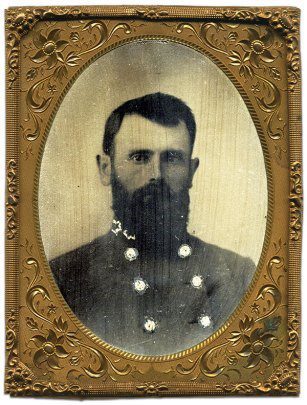
On July 2, 1863, during the second day of the Battle of Gettysburg, he was woken up at 4:00 a.m. and sent to Lee’s headquarters near the Lutheran Seminary. Lee ordered him to “check out the enemy’s left side and give a report as quickly as you can.”
Read the blog of Samuel Richard Johnston, Lee’s Reconnaissance Officer at Gettysburg, for the rest of the story.

He is buried in Section 44, Plot 161, with his first and second wives.
In the K portion of the Alexandria Presbyterian Cemetery H-N records:
K
The L entries in the Alexandria Presbyterian Cemetery H-N catalog include:
L
Gazaway Bugg Lamar (October 3, 1798 – October 5, 1874) Versatile Entrepreneur: Flourished as a Banker, Cotton Merchant, Shipbuilder, Steamship Pioneer, and Patron of Blockade Runners; United through Marriage with the Cazenove Family

Lamar was born in Georgia and became very rich during his lifetime. He started his businesses in Augusta, Georgia, his birthplace, and later moved to Savannah, Georgia. He was known for being a smart and successful businessman.
Please read the blog Gazaway Bugg Lamar: The Wealthy Banker, Cotton Merchant, and Steamship Pioneer Buried in the Presbyterian Cemetery for the rest of his story.
He was buried in 43:107 with his wife, Harriet.
Thomas Boyd Leadbeater (May 7, 1895 – September 14, 1913) was the grandson of William Gregory III.
A Gregory and Leadbeater family member, affectionately known as “Boyd,” sadly passed away on September 14, 1913. He was interred in Section 41, Plot 25.
The Leadbeater family were partners with the Stabler family in the Stabler-Leadbeater Apothecary shop on South Royal Street, now a museum.
The extensive M section of the Alexandria Presbyterian Cemetery H-N listings features:
M
Christina D. J. Copper Marsteller (1773 – January 5, 1815) Co-owner of the Spring Garden Farm
Buried either in Section 41:29 or Section 42, Christian and her husband, Philip Godhelp Marsteller (1770 – 1842), owned the Spring Garden Farm that eventually became the Wilkes Street Cemetery Complex. Philip was a member of the Relief Fire Company in 1795, attended Washington’s funeral, and was a member of Christ Church who left to organize St. Paul’s Church, which he gave land for their sanctuary. His father was Lieutenant Colonel Philip B. Marsteller (1741/2-1804), who was the Mayor of Alexandria, 1791 – 92, a charter member of the Alexandria Library Company in 1794, and was an honorary pallbearer at Washington’s funeral on December 18, 1799. The elder Marseller is buried at Christ Church.
Lewis McKenzie (October 7, 1810 – June 28, 1895) – Distinguished Civic Figure: Mayor, Congressman, and Key Contributor to the Formation of West Virginia
Read more about his remarkable life at this blog [Lewis McKenzie (1810-1895): A Civic Figure of Remarkable Influence].

Image from Harold Hurst’s book Alexandria on the Potomac.
Captain Charles McKnight (April 7, 1774 – March 11, 1853), Innkeeper of McKnight’s Tavern, Commanding Captain of the Independent Blues in the Battle of the White House
Also see Robert Allison, Jr., William Bartleman, and The Battle of the White House blog.
McKnight was a man who never got married. He led a group of soldiers called the Alexandria Blues during the Battle of the White House. After his father passed away, he owned the family tavern on the northwest corner of King and Royal Streets. He changed the tavern’s name to The Eagle Tavern (also known as Spread Eagle Tavern). As a result, that part of the town started being referred to as McKnight’s Corner.
He served as a judge from 1837 to 1853. He was also a member of Masonic Lodge 22 and wrote a book called “Captain Jack, or Old Fort Duquesne and Our Western Border One Hundred Years Ago.”

He is buried in Section 41:20.
Charles Henry McKnight (1840–1916)
A Sleeve Worn Bravely: The Life of Charles H. McKnight
Born: April 21, 1840
Died: August 15, 1916 (aged 76)
Charles H. McKnight was a native Virginian who served in the Confederate Army during the Civil War. He enlisted in 1861 with Company E, known as the Mount Vernon Guards, which became part of Company A, 17th Virginia Infantry Regiment, Fourth Brigade, Army of the Potomac, C.S.A. McKnight fought at the Battle of Williamsburg, where he was captured and later returned to service. He lost his right arm during the war, a sacrifice noted with admiration in the 1865 diary of Isabel Emerson: “I just adore that empty sleeve; he wears it bravely, knowing he lost his arm in defense of Southern rights and Southern honor.”
McKnight never married and lived the remainder of his life in Virginia. He died in 1916, and his funeral was conducted by Rev. Nourse. He is buried in Section 41, Plot 20.
An image of Charles’s gravestone appears below, alongside the biography of his brother, William.
John McKnight (July 2, 1769 – February 7, 1834) Sea Captain’s Odyssey: Captured Repeatedly by the French, Later Served as Alexandria’s Harbor Master
Born to William and Martha Bryan McKnight and a sibling to Captain Charles McKnight, he embarked on his journey as a ship captain at 19.
They were blessed with a dozen children in a union with Catherine Piercy from Philadelphia on October 29, 1799. Tragedy struck Catherine’s family during the harrowing Yellow Fever outbreak of 1793, which claimed the lives of 5,000 individuals in Philadelphia, including her father and one of her brothers. This epidemic shadowed the newly established United States government, as Philadelphia temporarily served as the capital. Following her familial losses, Catherine sought refuge with her Uncle on Prince Street in Alexandria, where she resided until her marriage to McKnight.
Encounters with French privateers punctuated McKnight’s maritime career during the Quasi-War with France, a conflict from 1792 to 1801. This turbulent period witnessed the French capture of over 1500 American ships.
In 1792, he was overhauled in the English Channel by the French privateer “L’Insurgente,” during the chase, McKnight was wounded in the leg by the privateer’s fire. He and his crew endured two years of captivity in Nantes, France. The ordeal exposed him to the grim realities of imprisonment, including arbitrary executions of fellow prisoners. He and his companions ingeniously fashioned makeshift ropes from blankets to scale the prison walls, facilitating their escape. (Source: Alexandria Historical Society, Fall 2009 Newsletter, Page 4)
Subsequently, he faced capture twice more while commanding the ship “Polly & Nancy.” The first incident occurred near the Capes of Virginia in 1797, and the second occurred near Cadiz in 1798. Following his release from captivity, a hurricane ravaged the “Polly & Nancy’s” masts as they journeyed back to Alexandria. Forced to part with the vessel, McKnight sold it in St. John’s, Antigua, the nearest port. This event marked the conclusion of his career as a ship captain. He also held partial ownership of another vessel named the “Adventure.”
On February 8th, 1834, the Alexandria Gazette featured the following entry:

McKnight is buried in Section 41:20. His wife died in 1867 and was buried next to McKnight in the cemetery.
William McKnight (1732 – July 25, 1812): Fort Duquesne Conqueror during the French and Indian War and Founder of McKnight’s Tavern
William, Captain in the First Battalion of the Pennsylvania Provincials as detailed in ‘Officers and Soldiers in the Service of the Province of Pennsylvania, 1744-1765’ (p. 20), played a pivotal role in capturing Fort Duquesne, later renamed Fort Pitt, during the French and Indian War. In 1775, he relocated to Alexandria, where he opened a tavern. 3
The tavern, a wooden structure at the intersection of King and Royal Streets, boasted a distinctive feature: the “Long Room” on the second floor, often employed by Washington for discreet gatherings. Additionally, the establishment served as a favored venue for Alexandria’s St. Andrews Society meetings. Interestingly, the contemporary successor of this society now orchestrates the annual Scottish Christmas Walk parade in Alexandria, held on the first Saturday of December.
William was initially wedded to Martha Bryan (1745 – June 3, 1775), with whom he had two sons, John and William Henry. Martha found her resting place in Section 41, Plot 20, with her tablet gravestone, one of the oldest in the Presbyterian Cemetery.
Following Martha’s passing, William entered into matrimony with Susannah Evans (September 19, 1746 – November 10, 1836). All are buried in the Presbyterian Cemetery.
| to the memory of WILLIAM McKNIGHT who departed this life on the 25th of July 1812 in the 80th year of his life MARTHA BRYAN Wife of WILLIAM McKNIGHT departed this life JUNE 3, 1775 aged 30 years |
William Henry McKnight (August 24, 1800 – December 29, 1887), Master Builder and Carpenter: Oversaw Lumber Measurement, Endured Civil War Arrest and Imprisonment in Old Capitol Prison in Washington, D.C.
William McKnight’s son was a skilled carpenter who established workshops in several locations over the years. In 1834, he set up a shop on Union Street near Gibbon Street. However, in 1852, he relocated the shop to Union Street near Prince Street. Tragically, this shop was destroyed by fire in 1854. He also managed workshops on St. Asaph Street and Prince Street. His business partner was David Price, and together, they repurposed bricks from the original St. Mary’s Chapel to build the Lyceum. Additionally, they constructed houses at 523-529 and 531 South Lee Street between 1831 and 1865. 1859, they constructed the Depot Building for the New York and Virginia Steamship Co. Following the fire that consumed the Market House in 1871, they erected a warehouse near the market house for William Gregory, Beach, and Brill. Finally, in 1870, McKnight built his residence at 208 South St. Asaph Street.
During the Civil War, the U.S. Army arrested him and other Alexandrians in February 1862 for allegedly supporting the rebels by aiding the families of those absent in the Confederate army. He spent a month in the Old Capitol Prison, previously the Old Brick Capitol, serving as the temporary U.S. Capitol from 1815 to 1819 and later as a prison for Southern loyalists during the Civil War. The building was demolished in 1929, and the U.S. Supreme Court now stands on its site.
William McKnight married Margaret Jacobs on January 28, 1802. Margaret Jacobs passed away on February 7, 1888. Together, they had five children, three buried in the Presbyterian Cemetery. The names of their children were Elizabeth Chew McKnight (born April 2, 1833, died November 16, 1911), William Presley McKnight (born June 12, 1838, died October 24, 1927), and Charles Henry McKnight (born April 21, 1840, died August 15, 1916).
William Presley McKnight (1838–1927) From Battlefield to Newsroom: A Life of Service and Survival
Born: June 12, 1838
Died: October 24, 1927 (aged 89)
William Presley McKnight, known as “Willie,” was a lifelong Alexandrian who served with the Confederacy during the Civil War. He enlisted in 1861 with the Mount Vernon Guards, which became Company E of the 17th Virginia Infantry Regiment, part of the Fourth Brigade, Army of the Potomac, C.S.A. Rising to the rank of lieutenant, McKnight saw extensive service and endured multiple captures—at Frayer’s Farm and again at Antietam. One account suggests he may have been wounded aboard a steamer departing Fort Monroe in May 1862 and taken prisoner.
McKnight never married and returned to Alexandria after the war, where he served for many years as the business manager of the Alexandria Gazette. His wartime correspondence with his brother Charles H. McKnight was later published in The American Civil War Letters of William and Charles McKnight of Alexandria, Virginia. His life and service are also documented in The McKnights of Alexandria, a chapter in A Composite History of Alexandria.
He lived into his late 80s, passing away in 1927, and is remembered for both his military service and postwar civic contributions.

| WILLIAM PRESLEY McKNIGHT born June 12, 1838 died Oct. 24, 1927 | CHARLES HENRY McKNIGHT son of WILLIAM H. and MARGARET J. McKNIGHT born April 21, 1840 died November 16, 1911 He giveth his beloved sleep |
Legacy of Craftsmanship and Enterprise: The Muir Family of Alexandria
In the late 18th century, a skilled craftsman named John Muir emigrated from Scotland to the United States, choosing Alexandria, Virginia, as his new home. His arrival, around 1790, marked the beginning of a legacy that would intertwine with the city’s history. Although there is mention of a John Muir in earlier census records and another Muir active in the region, their connections, if any, to our John Muir remain a historical ambiguity.
John Muir, together with his wife Mary Lang Muir, also a Scot, raised a family of six children in Alexandria. Their lives and fortunes were deeply intertwined with the fabric of the city. Their daughter Jane married into another prominent furniture-making family, tying the knot with James Green (see Ivy Hill Cemetery where he and Jane are buried), son of William Green, a pioneer in Alexandria’s furniture manufacturing.
John Muir’s professional journey was marked by ambition and collaboration. In 1794, he and a partner named Buckland embarked on a venture as cabinet and chair manufacturers on Fairfax Street. They aspired to match the standards of Philadelphia and Baltimore’s finest. However, by 1797, this partnership had dissolved, leading Muir to continue his craft on Royal Street. His advertisments for apprentices and mahogany, coupled with various local records, paint a picture of a man deeply engaged in his community until his demise in 1815.
Surviving account books housed in the Local History/Special Collections at the Kate Waller Barrett Branch Library, covering the years 1807 to 1815, illuminate the diversity and intricacy of John Muir’s craftsmanship. His workshop produced a wide range of items, from coffins to elegant sideboards, high-post beds, and practical tables, catering to various needs. Muir’s clientele, including Alexandria’s elite such as Judge Bushrod Washington and Dr. Craik, highlights his reputation for quality and skill. His Masonic ties, particularly with Brooke Lodge No. 47, and the mentorship of apprentices William and Walter Hannon, further underscore the lasting impact of his work and legacy.
John Muir’s personal life was marked by both typical and complex facets of the era. He owned a slave, as recorded in the 1810 census, a common yet somber aspect of his time. After his death in 1815, his widow Mary carried on the business, a testament to her resilience and skill.
The legacy of John Muir’s craftsmanship extends to the present day, with surviving furniture pieces from his workshop being highly prized. These pieces, when they appear on the market, can fetch high prices, coveted by collectors and historians for their quality, beauty, and historical significance.
The Muir family’s story took dramatic turns during the Civil War. The family split in their loyalties; while Stephen Shinn, who had married Mary’s younger sister, sided with the North, James Green, Jane, and their children leaned towards the South. This dichotomy in the family was later depicted in the PBS miniseries ‘Mercy Street,’ set in the Mansion House Hospital in Alexandria, offering a glimpse into the era’s complexities.
John Muir’s influence persisted through generations. His grandson, John A. Muir, became Alexandria’s mayor, and alongside his brother James F. Muir, they continued the family’s furniture business, a legacy proudly noted in the Alexandria Gazette in 1876.
This narrative of the Muir family, from John’s arrival in Alexandria to his descendants’ contributions, weaves a rich tapestry of craftsmanship, civic duty, and the complexities of life in a changing America.
| Sacred to the memory of JOHN MUIR who departed this life February 12, 1815 in the 45th year of his age My glass is run and yours are running remember death for Judgement’s comeing also JAME MUIR son of JOHN and MARY MUIR departed this life July 11th 1814 in the 5th year of his age |
| JOHN A. MUIR 1849 – 1925 |
| In Memory of MARY MUIR (Relict of the late JOHN MUIR) who died May 24, 1841 aged 61 years After a Christian Experience of 34 years she was able in life Last struggle to exclaim The Lord is the portion of his people |
| WILLIAM H. MUIR born March 5, 1814 died Aug. 15 1891 Comfort ye comfort ye my people saith your God. He givieth power to the faint and to thn that have no might he increaseth strenght but they that wait upon the Lord shall renew their strenght they shall mount up with wings as eagle they shall run and not be wear, and they shall walk, and not faint. |
| MUIR, JAMES F. 1846 – 1925 |
| ELIZA A. GREEN wife of WM. H. MUIR born Aug. 7, 1822 died Jan. 27, 1862 And I heard a voice from heaven saying unto me, write; blessed are the dead which die in the Lord. |
Completing the Alexandria Presbyterian Cemetery H-N directory are these N surnames:
N
Joseph Hazel Newell (April 5, 1890 – March 10, 1973) Cemetery Trustee
An active participant at the Second Presbyterian Church and dedicated cemetery trustee. Buried in 44:133.
John Thomas Newton, born on May 20, 1794, and died on July 28, 1858, is laid to rest in Alexandria’s Presbyterian Cemetery. In the early years of the United States Navy, he was a highly regarded officer. Starting in 1809, Newton served in the US Navy for an impressive 48 years. During the War of 1812, he held the rank of Lieutenant on the USS Hornet, a ship that sank the HMS Peacock near the coast of South America. For his bravery, the US Congress honored him with a Silver Medal (Captain James Lawrence, the ship’s commander, received a Gold Medal). Furthermore, the people of Alexandria presented him with a sword to recognize his heroism during the War of 1812.
Read more about Newton at this blog: Thomas Newton: a Respected Navy Officer and Hero of the War of 1812

William Newton (1763 – 1814) was a Revolutionary War Veteran.
He was born on either February 25, 1763 or February 26, 1765, in “Little Falls Plantation” in Stafford County, Virginia. He moved to Alexandria by at least 1786, where he embarked on a successful career as a merchant. He co-founded “William Newton and Co.” and advertised their business in the local newspaper in 1786. Later, he became a partner in the firm of Ricketts and Newton.
William Newton was a businessman and a patriot, as he served in the Revolutionary War, a fact acknowledged by the Sons of the American Revolution, who included his name on a plaque at the entrance to the Presbyterian Cemetery. He was a charter member of the Alexandria Library Company in 1794 and an active member of the Relief Fire Company in the same year. Additionally, he was a Mason in Lodge 22.
William Newton played a role in establishing the Bank of Alexandria, as evidenced by his signature on the petition dated October 9, 1792. He was also a slaveowner in 1789 and 1800, owning a single slave. In the 1810 census, he was recorded as owning five slaves.
Buried by Rev. Muir, 28 December 1814, 50 years of age. Died during an epidemic.
| Our Parents Died on the 26th Decbr. 1814 WILLIAM NEWTON in the 52nd year of his age The world passeth away but he that doeth the will of God abideth forever. Died on the 25th Feb. 1815 JANE B NEWTON in the 39th year of her age For the Lord shall be thine everlasting light and the days of thy mourning shall be ended. We are more than conquerors through him that loved us. For if we believe that Jesus died and rose again, even so, them also which sleep in Jesus will God bring with him. |
Jane Barr Stuart Newton (c.1776-1815)
Jane was the daughter of William and Jane Barr Stuart, who resided at “Cameron,” located west of Alexandria. She married William Newton on February 7, 1792, in a ceremony officiated by Rev. Muir. Tragically, Jane passed away on February 25, 1815, at 39, succumbing to a decline in her health. She was buried in the Presbyterian Cemetery, with her burial also conducted by Rev. Muir.
William Newton and Jane Barr Stuart Newton were a prominent couple in Alexandria, with William’s business ventures and civic involvement contributing to the community. At the same time, Jane played her role as a daughter and wife within the social context of the time.
| Our | Parents |
| Died on the 26th Decbr. 1814 WILLIAM NEWTON in the 52nd year of his age The world passeth away but he that doeth the will of God abideth forever. | Died on the 25th Feby. 1815 JANE B[arr Stuart]. NEWTON in the 39th year of her age For the Lord shall be thine everlasting light and the days of thy mourning shall be ended. We are more than conquerors through him that loved us. For if we believe that Jesus died and rose again, even so them also which sleep in Jesus will God bring with him. |
This concludes the Alexandria Presbyterian Cemetery H-N section, representing just a third of the remarkable individuals interred here. Explore our companion directories covering surnames A-G and O-Z for a complete history of our cemetery’s notable residents. The Alexandria Presbyterian Cemetery H-N catalog is regularly updated as new historical information becomes available.
Sources and References
For a full list of sources, please see the Sources and References section on the main page.
